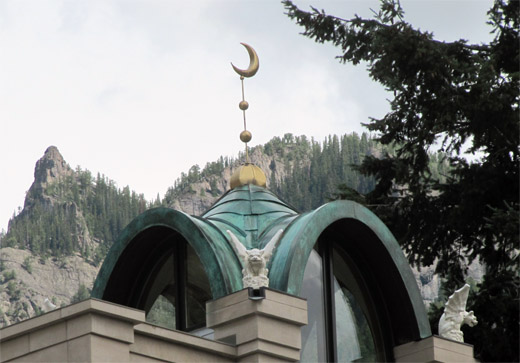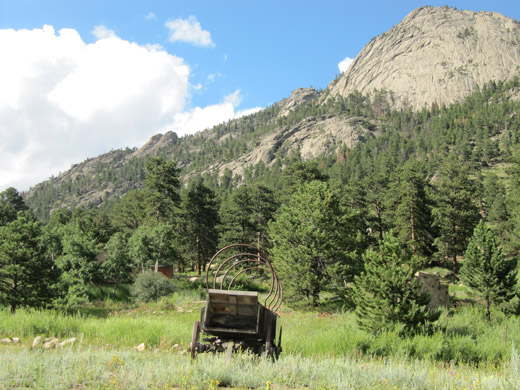 I was heartened to find them right where I left them: the Notre Dame chimera and his beak-faced buddy leering over the baggage carousels at Denver International Airport. I landed in Colorado just as the news broke that the state’s cutest pests were busily vectoring some good, old-fashioned plague, and my first thought (after “¡ay caramba!“) was to wonder what other medieval grotesquerie I might encounter.
I was heartened to find them right where I left them: the Notre Dame chimera and his beak-faced buddy leering over the baggage carousels at Denver International Airport. I landed in Colorado just as the news broke that the state’s cutest pests were busily vectoring some good, old-fashioned plague, and my first thought (after “¡ay caramba!“) was to wonder what other medieval grotesquerie I might encounter.
Medieval Europe casts a strange, slanting shadow across the American West, even before you take into account the culture and traditions of Spanish speakers. (It’s not for nothing that the 1984 book The Medieval Heritage of Mexico is 600 pages long.) For generations, we Americans were fond of imagining that we’d made a clean break from Europe—“Shrouded bards of other lands! you may sleep—you have done your work”—but in the deserts and prairies, that belief is still duking it out with evidence that we’re the blatant heirs to medieval traditions.
False starts abound there, too. At Mesa Verde National Park, we were gawking at Far View House, the ruin of an Ancestral Puebloan home built between 1100 and 1300 A.D., when my wonderfully indulgent traveling companion spotted this:

Could it be? The remains of an Ancestral Puebloan gargoyle that once spewed forth some of the mesa’s 18 inches of summer rain—set in place at the same time Europeans were building great Gothic cathedrals? Could a medieval French architect have been shipwrecked on our shores and then whisked away to the desert by a super-tornado? Perhaps with the aid of medieval Welsh UFO abductees?
Alas, no. Those drainage stones only look old; they were placed there by the National Park Service to draw water away from the fragile sandstone ruins. The two rangers who answered my questions seemed awfully embarrassed that somebody noticed.
In Ouray, Colorado, which bills itself as “the Switzerland of America,” I spotted familiar beasties atop the local pharmacy museum:

As common as prairie dogs, these grotesques are variants of a standard garden-store and souvenir-shop species known as the “Florentine gargoyle.” They usually have dog or cat faces, and they often have chains around their necks. If their ancestors actually lurk on a landmark in Florence, I’m still hunting for them.
Fortunately, other, more perspicacious medievalists have moseyed down this road. In his 1965 article “The Legacy of the Middle Ages in the American Wild West,” historian Lynn White, Jr., argued that pioneers were “particularly beneficiaries of the Middle Ages” whose “essential equipment was largely the culture of the mediaeval lower classes.” Log cabins? A medieval building style brought to North America by Swedes, reintroduced by the Germans and the Swiss, and carried westward by Scotch-Irish settlers. Stirrups? Eighth century. Spurs? Late 13th century. The distillation of spirits, card games, garter belts, the title “sheriff,” and even lynching? All of them, White argues, were “medieval patterns of preference” that shaped the American West.
Of course, White belonged to a school of historians who were obsessed with showing irrefutable continuity from the Middle Ages to the present. “Indeed,” he surmised, “a good case could be made for the thesis that today the United States is closer to the Middle Ages than is Europe.” In his 1965 article, he’s eager to believe it’s so. He’s not wrong when he claims that the revolver, barbed wire, and the windmill couldn’t have existed without medieval innovations in gunpowder, drawing wire, and water pumping—but sometimes he seems to be trying too hard.
That said, one of White’s revelations is particularly neat. To find traces of the Middle Ages in Colorado, you need to look no further than the countless squares, parks, and museums for the carcasses of a conveyance that most people don’t consider “medieval” at all.

The Conestoga wagon! To generations of Americans—and to the throngs of European tourists I saw at the national parks last week—it’s an icon of the Old West. I’d assumed it was the culmination of 19th-century New World ingenuity, but White makes a case for its medieval-ness.
The Romans, he argues, had nothing quite like it. The earliest example of a harness with padded collars and lateral traces or shafts pops up only around the year 800. Nailed horseshoes, which gave horses traction and reduced wear on their hooves, first appear in the 890s. Finally, around 1070, we see the first evidence for the humble but ingenious “whipple tree,” the rod across the front of a cart that connects the sides of tandem animals to the front and center of the cart, equalizing the pull and making the whole contraption safer and more efficient.
Capable of hauling several people and heavy loads, the large frontier wagon, the longa caretta, is now feasible—just add youthful sinewy races full of manly pride and friendship. “In the early twelfth century,” White concludes, “it appears in essentially the same form which came to dominate the American West in the Conestoga wagon.” O pioneers!
Is he right? I don’t know. Historians bicker mightily about the timing of the first nailed horseshoes, and when I look at the marginal doodad on the Bayeux Tapestry that White believed was the first evidence for the whipple-tree, I just don’t see it. But his explanation is plausible (and great fun), as is his underlying belief in the medieval-ness of the United States:
We Americans greatly puzzle Europeans, including Britons, because whereas every European state assumes absolute sovereignty, even over religion, we are still happily mediaeval in political concepts and deliberately splinter sovereignty quite minutely. The central issue in American domestic politics at present is whether, or the extent to which, our mediaeval legacy of pluralism is still viable.
“The Legacy of the Middle Ages in the American Wild West” is nearly half a century old, but White could have written those words yesterday—or a decade from now. The road goes ever on and on, leading us back to medieval Europe, even when we’re positive we’re headed west.


Quite apart from the medieval antecedents of the prairie schooner, I am fascinated by the ‘Florentine’ gargoyles on the pharmacy museum. The compounding pharmacy that’s next to my local grocery store has a brace of them on its facade. It may well be coincidence, but what a funny one!
LikeLike
If you’re able, please snap a photo the next time you’re at the pharmacy. I’d get a kick out of that!
The fact that these guys are on your local pharmacy speaks to their ubiquity. (I have four of them on indoor ledges.) I’ve found references to the “Florentine gargoyle” in garden-supply advertisements in magazines like the New Yorker in the early 1990s, but now I’m wondering if it’s a case of deceptive American branding. These statues so perfectly confirm post-medieval assumptions about medieval grotesques that I’m expecting to find a fairly stunted pedigree—but we’ll see…
LikeLike
About 40 years ago, somebody told me that a math and science building at the University of Colorado was spoken of as “Iowa Gothic”. As I recall, it had the usual academic sandstone look for about four stories, then a tower that the locals thought looked like a grain elevator.
LikeLike
I just checked out the building online. It’s certainly odd! What’s interesting about UC-Boulder is that the first buildings on the campus followed the Collegiate Gothic fad of the time, and then the same architect, Charles Klauder, suddenly decided to come up with something far more appropriate to the colors and landscape of Colorado.
Most proponents of Gothic architecture in America were usually too ideologically invested in the style to give it up, so it’s interesting to me that Klauder actually did—and then apparently went back to neo-Gothic in his designs for college buildings elsewhere in the country. I’ll have to learn more about him to figure out what was going on there…
LikeLike
Lynne White’s ideas did spark some fierce scholarship by people who disagreed with him. A handy overview of the work by Roman archaeologists who felt that he underrated Roman vehicles is http://www.humanist.de/rome/rts/index.html Whatever the Romans did, a lot of their technologies had to be reinvented and improved upon in the last thousand years.
LikeLike
Sean: Thanks for stopping by! I’ve not had time to track down responses to White’s work, so I greatly appreciate that link. I’ll read it, and I’d encourage anyone else who’s intrigued by this question to check it out as well.
LikeLike
There’s a gargoyle-chemist compounding drugs here, to go with your pharmacy: http://www.scoutingny.com/hogwarts-in-manhattan-the-1000-gargoyles-grotesques-of-city-college/
LikeLike
City College is one of those places I’ve meant to visit with my camera for a long time. (The list of destinations is depressingly long.) I’ll tell its story on this blog eventually, but in the meantime, I’m amused that that location-scout blogger’s sees American neo-Gothic architecture and thinks “Hogwarts.”
LikeLike